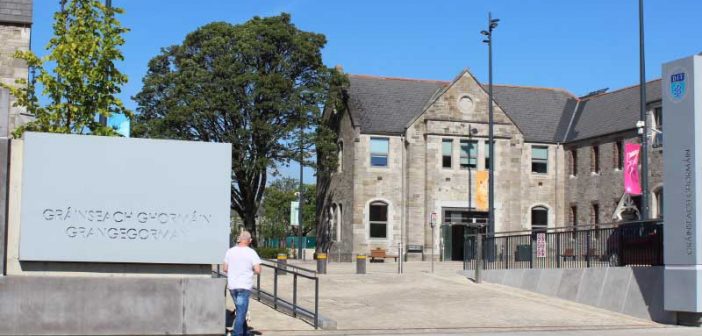GDA BIM/Information Manager Robert Moore talks with Irish building magazine about his work in managing the GDA’s information, through BIM methodologies, which will be handed over to Technological University Dublin, the Health Services Executive and the Department of Education & Skills.

Robert Moore
The Grangegorman Development Agency (GDA) is creating a brand-new piece of Dublin in the north inner city. With health, education and community at its heart, this exciting new quarter is opening up once closed off institutional land to the city and creating new connections to the city centre and the northern suburbs. Grangegorman will be home to the new Technological University of Dublin (formerly DIT) city campus and already has a range of health and community facilities up and running across the site. Robert talks about the GDA’s work and gives advice from his experience as one of the first BIM Managers in the public sector.
Can you tell us about your professional background, qualifications and memberships?
I have worked as an Information Manager since 2012 and I’ve been involved in the construction industry for over 20 years. My background is in the MEP sector, working for both SMEs and large multidisciplinary international organisations. I have a Master’s (first-class honours) in Construction Informatics. I am also a certified RICS BIM Manager. I have three published papers on Information Management and have spoken at several conferences. I am also a current and active committee member of the National BIM Mirror Committee, Public BIM and previously participated as a Lean Construction Ireland (LCi) Leadership Group Member, BIM Innovation Capability Programme Client Working Group Member and Eastern BIM Region Steering Committee Member.
What were the milestones in your career before your current role?
After spending 12 years working for Building Services consultancies as a CAD manager using 2D drafting, I moved to 2D coordination for M&E contractors, this exposed for me the gap between the information that was traditionally produced by 2D methodology to what was needed on site. Progressing to 3D modelling was an obvious move with this experience and I made this move in 2009 working on T2 at Dublin Airport. I then worked on the Intel retooling project in 2012, as a BIM team lead, where I learned the value of process driven workflows and how they improved quality and productivity. This led me to Lean, which is my focus today, to digitise a Lean process.
Can you tell us about your role at the GDA?
I’ve been the Information Manager in Grangegorman since 2016. I lead on the managerial and technical requirements for Information Management across the development of Grangegorman. I ensure that the GDA’s information is fit for purpose and is structured to help with better decision making, to this end, I am developing Standard Methods and Procedures (SMP) and a Quality Assurance and Quality Control (QA/QC) system for the GDA’s information, that is compliant to AEC industry information standards like recently published ISO 19650-1 and -2. I also work with the supply chain, predominantly design teams and their consultants at the moment, to develop their capacity to deliver a quality product.
Who are the stakeholders?
Technological University Dublin (TU Dublin), the Health Service Executive, Dublin 7 Educate Together, The Department of Education and Skills, and the surrounding communities are our main stakeholders. However, as a new piece of the city and a major piece of national infrastructure, we would consider the wider citizenry a stakeholder too.
How has your interest in Lean Construction influenced your work?
For me, BIM is about the process, not a model. Lean is all about process and culture, so I see BIM as a subset of Lean. With culture being the most important element of Lean, the construction industry needs cultural change to adopt the processes required to get the efficiencies promoted by BIM. So for me, Lean is fundamental to the successful deployment of BIM.
Can you tell us about the BIM team on campus?
I see everybody as being in the BIM team, our entire GDA team and our supply chain (design teams and contractors predominantly). We all need information to perform distinct roles. We all need to create, access and reuse information easily. We aim to ensure that everyone has access to the right information; to make the right decisions. Saying that Information Management is the sole responsibility of the ‘BIM Department’ is misguided, it is not the right approach.
How was BIM used on the planning of the campus (strategy, goals, and objectives)?
The original campus master plan was completed in 2008 using traditional Information Management processes, with BIM first being specified in 2012 on the Greenway Hub building. This was a very progressive move by the GDA as it was the year before PAS 1192-2 was published. We learned a lot from completing a project that specified BIM and now we are implementing a unified Information Management structure across the campus.
How do you think digital construction has changed the construction industry and the value that contractors can offer?
Digital construction is about doing more for less. The client wants an asset that is value for money and built to a high standard. The contractor wants an easily executable project.
It is all about getting these results, a win-win for everyone.
What were the benefits of BIM on the Grangegorman projects to date?
Better collaboration within the teams, which we hope means happier, more productive development partners. Organising information was easier, information was usable, and it helped management in decision making.
How is data being prepared for the management and maintenance of buildings?
The management and maintenance will be done by the end users, TU Dublin, the HSE and the DoES. For a successful handover, it is important that the information is correct, classified and structured. Classification is often overlooked but it is very important so that data can be used in difference CAFM systems.
Is Grangegorman a milestone development for digital construction in Ireland?
Yes. Grangegorman was one of the first state projects to embrace digital construction and specify BIM. We are continuously working with our supply chain to develop better ways to deliver this large state asset. We still want to be progressive and now hope to be one of the first government bodies to move to ISO 19650-1 and -2.
What can other clients and project teams learn from the Grangegorman campus and What is your advice to delivery teams thinking of bidding for future projects??
We have learned that it is important to have your processes well mapped out and to be focused on the quality of the information. This will reduce problems downstream.
Delivery teams should ensure they have good Procedures and Quality Management within their organisation. This is fundamentally all they need to put them in a good place to win work at Grangegorman.
What is your advice to public sector clients looking at the application of BIM on their projects?
With the mandate coming into effect it is important that public sector organisation develop processes and structures within their organisation to accept structured information at handover for the operation of the facilities.
If they do not have their processes and structures in place then this structured information delivered to them will quickly revert back to unstructured information and the value will be lost.
Have you advice for clients with large projects and contractors working on those projects?
Clients, design teams and the contractors need to work collaboratively and maintain a good relationship. Clients should specify what they want as outcomes, like sustainability goals, operation ease and allow the supply chain to innovate to deliver this. The client should start with Plain Language Questions and develop them into Information Requirements that are ‘SMART’ (Specific, Measurable, Assignable, Realistic, Time-related).
Can you tell us about the ISO working group you are working in?
The CEN/TC 442 Building Information Modelling (BIM) Mirror Committee in NSAI is tasked with reviewing proposed ISO standards for Ireland. I will be representing the committee at the ‘Guideline for the implementation of BEP and EIR on a European level based on EN ISO 19650-1 and -2’ Task Group meeting, which will be in Delft in March.
How did Public BIM come about and is the GDA heavily involved?
Public BIM came about through meetings between GDA and Dublin City Council to share resources, discuss solutions to common problems, as we wanted to have a common approach to the engagement with our supply chain. From 2, the group quickly grew to over 40 state bodies who attend meetings regularly. The original focus for the group was to share knowledge and networking. The OGP now chairs the group and our objective is to have a standard approach and standard procedures across the public sector.
Can you tell us about the 3DC (3D City) Hackathon coming up in Dublin?
The GDA, DCC, Smart Docklands and the Open Data Unit DPER (Department of Public Expenditure and Reform) plan to host a Hackathon in mid-May. The event will be using the new spatially accurate 3D Virtual City Model of the Docklands and data rich IFC building models. We want to look at how this data could be used for Public Good, if it was made available as Open data. Keep an eye on Eventbrite for more information.




